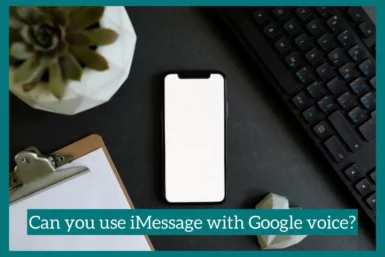Is it possible to use Google Voice with iMessage? If you’ve ever wondered how these two communication platforms interact, you’re in the right place.
In this article, we’ll discuss iMessage and Google Voice connectivity and the alternative options to make it happen.
How Does a Google Voice Number Work?
A unique communication option offered by Google Voice is the ability for users to have a single phone number that can be used across several devices. Here’s a thorough breakdown of how Google Voice numbers work.:
- Virtual Phone Number: When you sign up for Google Voice, you receive a virtual phone number. Based on your preferences and availability, you can choose this number to be your primary point of contact.
- Call Forwarding: Call forwarding to many devices is available using Google Voice. You can connect your virtual number to a landline, a mobile device, or even a computer. Whenever someone calls your Google Voice number, the call is forwarded to the device or devices you’ve designated so you never miss a call.
- Voicemail and Transcription: When you’re unable to answer calls, Google Voice’s voicemail service will record messages for transcription. Any device linked to your Google Voice account can access these voicemails. The voicemails can also be converted into text using Google Voice, which makes them simpler to read and comprehend.
- Customizable Call Handling: Call handling that may be customized based on your needs is possible with Google Voice. You can establish criteria for incoming calls, such as having calls from specific contacts forwarded straight to your mobile phone while directing calls from other contacts to voicemail or completely blocking obtrusive calls.
- Text Messaging and Online Access: Using your virtual number, Google Voice lets you send and receive text messages in addition to taking calls. These messages are flexible and convenient to access from your mobile device or through the Google Voice website.
Can You Use iMessage with Google Voice?
Apple’s instant messaging service, iMessage, is made to function well inside the Apple ecosystem. It does not, however, integrate with Google Voice.
This is because iMessage does not allow users to use any number other than the Simcard number to use for iMessage. This means that you cannot use iMessage with a Google voice number. What you need to know is as follows:
Limitations of iMessage
iPhones, iPads, and Macs are the only devices that support iMessage. It is dependent on Apple’s exclusive messaging system; hence it cannot be used with Google Voice natively on non-Apple devices.
Integration with Apple ID
To send and receive messages, your Apple ID is connected to iMessage. Google Voice is incompatible with iMessage since it runs independently and does not use Apple IDs.
Workarounds
Although iMessage and Google Voice do not officially integrate, there are other ways to send and receive texts.
For instance, you can retrieve your Google Voice messages on your iPhone using the Google Voice app or website. Further, you may configure Google Voice to forward SMS messages to your iPhone’s SMS app so that you can receive them there.
Alternative Methods to Use iMessage
Even though iMessage is primarily made for Apple devices, there are a few more approaches you may take to enjoy iMessage-like functionality on non-Apple platforms.
Here are some alternatives to think about:
1. Third-Party Apps
A few third-party applications try to close the communication gap between non-Apple devices and iMessage. These apps frequently demand that both the sender and recipient install them.
They provide functionality like iMessage and features like end-to-end encryption, although they might not perfectly duplicate the original iMessage.
2. Dual-Boot or Virtual Machines
You can use virtual machines, dual-boot setups, or emulators to run iOS on non-Apple devices. You may now use iMessage directly from your device due to this. Although technically challenging, setting up and maintaining such arrangements may not be doable for everyone.
3. Cross-Platform Messaging Apps
There are several apps that are compatible with many operating systems if you’re searching for a more comprehensive cross-platform messaging solution.
WhatsApp, Signal, Telegram, and Facebook Messenger are well-known examples. These apps provide text messaging, multimedia sharing, and encryption features comparable to iMessage.
Conclusion
In conclusion, even if iMessage and Google Voice cannot be directly integrated, there are other ways to handle your communications requirements.
Making wise choices about communicating across many platforms requires an understanding of the limitations of iMessage and Google Voice compatibility. There are ways to bridge the divide, including using the Google Voice app or website on your iPhone, setting up message forwarding, looking into third-party apps, or choosing cross-platform messaging solutions.
The best alternate option depends on your device choices and desired functionalities. By investigating these options, you may improve your messaging experience and maintain contact with friends, family, and coworkers even if you are not a part of the Apple ecosystem.

